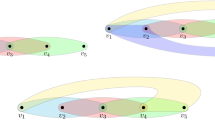Abstract
The Bose-Hubbard model is a system of interacting bosons that live on the vertices of a graph. The particles can move between adjacent vertices and experience a repulsive on-site interaction. The Hamiltonian is determined by a choice of graph that specifies the geometry in which the particles move and interact. We prove that approximating the ground energy of the Bose-Hubbard model on a graph at fixed particle number is QMA-complete. In our QMA-hardness proof, we encode the history of an n-qubit computation in the subspace with at most one particle per site (i.e., hard-core bosons). This feature, along with the well-known mapping between hard-core bosons and spin systems, lets us prove a related result for a class of 2-local Hamiltonians defined by graphs that generalizes the XY model. By avoiding the use of perturbation theory in our analysis, we circumvent the need to multiply terms in the Hamiltonian by large coefficients.
Reference [1] is a detailed technical version of this extended abstract.
Access this chapter
Tax calculation will be finalised at checkout
Purchases are for personal use only
Preview
Unable to display preview. Download preview PDF.
Similar content being viewed by others
References
Childs, A.M., Gosset, D., Webb, Z.: The Bose-Hubbard model is QMA-complete. arXiv:1311.3297
Bookatz, A.D.: QMA-complete problems. arXiv:1212.6312
Kitaev, A.Y., Shen, A.H., Vyalyi, M.N.: Classical and Quantum Computation. American Mathematical Society (2002)
Kempe, J., Regev, O.: 3-Local Hamiltonian is QMA-complete. Quantum Inf. Comput. 3(3), 258–264 (2003)
Kempe, J., Kitaev, A., Regev, O.: The complexity of the local Hamiltonian problem. SIAM J. Comput. 35(5), 1070–1097 (2006)
Oliveira, R., Terhal, B.M.: The complexity of quantum spin systems on a two-dimensional square lattice. Quantum Inf. Comput. 8(10), 900–924 (2008)
Aharonov, D., Gottesman, D., Irani, S., Kempe, J.: The power of quantum systems on a line. Commun. Math. Phys. 287, 41–65 (2009)
Gottesman, D., Irani, S.: The quantum and classical complexity of translationally invariant tiling and Hamiltonian problems. Theory Comput. 9(2), 31–116 (2013)
Bravyi, S.: Efficient algorithm for a quantum analogue of 2-SAT. Contemp. Math. 536, 33–48 (2011)
Gosset, D., Nagaj, D.: Quantum 3-SAT is QMA1-complete. In: 54th FOCS, pp. 756–765 (2013)
Bravyi, S., DiVincenzo, D.P., Oliveira, R.I., Terhal, B.M.: The complexity of stoquastic local Hamiltonian problems. Quantum Inf. Comput. 8(5), 361–385 (2008)
Bravyi, S., Terhal, B.: Complexity of stoquastic frustration-free Hamiltonians. SIAM J. Comput. 39(4), 1462–1485 (2009)
Wei, T.C., Mosca, M., Nayak, A.: Interacting boson problems can be QMA hard. Phys. Rev. Lett. 104(4), 040501 (2010)
Liu, Y.K., Christandl, M., Verstraete, F.: Quantum computational complexity of the N-representability problem: QMA complete. Phys. Rev. Lett. 98(11), 110503 (2007)
Schuch, N., Verstraete, F.: Computational complexity of interacting electrons and fundamental limitations of density functional theory. Nature Phys. 5(10), 732–735 (2009)
Cubitt, T., Montanaro, A.: Complexity classification of local Hamiltonian problems. arXiv:1311.3161
Fisher, M.P.A., Weichman, P.B., Grinstein, G., Fisher, D.S.: Boson localization and the superfluid-insulator transition. Phys. Rev. B 40, 546–570 (1989)
Childs, A.M., Gosset, D., Webb, Z.: Universal computation by multiparticle quantum walk. Science 339(6121), 791–794 (2013)
Feynman, R.P.: Quantum mechanical computers. Optics News 11, 11–20 (1985)
Janzing, D., Wocjan, P.: BQP-complete problems concerning mixing properties of classical random walks on sparse graphs. arXiv:quant-ph/0610235
Aharonov, D., Ta-Shma, A.: Adiabatic quantum state generation and statistical zero knowledge. In: 35th STOC, pp. 20–29 (2003)
Jordan, S.P., Farhi, E.: Perturbative gadgets at arbitrary orders. Phys. Rev. A 77(6), 062329 (2008)
Mizel, A., Lidar, D.A., Mitchell, M.: Simple proof of equivalence between adiabatic quantum computation and the circuit model. Phys. Rev. Lett. 99(7), 070502 (2007)
Landau, L.D., Lifshitz, E.M.: Quantum mechanics: non-relativistic theory. Pergamon Press (1994)
Nagaj, D., Mozes, S.: New construction for a QMA complete three-local Hamiltonian. J. Math. Phys. 48(7), 072104 (2007)
Author information
Authors and Affiliations
Editor information
Editors and Affiliations
Rights and permissions
Copyright information
© 2014 Springer-Verlag Berlin Heidelberg
About this paper
Cite this paper
Childs, A.M., Gosset, D., Webb, Z. (2014). The Bose-Hubbard Model is QMA-complete. In: Esparza, J., Fraigniaud, P., Husfeldt, T., Koutsoupias, E. (eds) Automata, Languages, and Programming. ICALP 2014. Lecture Notes in Computer Science, vol 8572. Springer, Berlin, Heidelberg. https://doi.org/10.1007/978-3-662-43948-7_26
Download citation
DOI: https://doi.org/10.1007/978-3-662-43948-7_26
Publisher Name: Springer, Berlin, Heidelberg
Print ISBN: 978-3-662-43947-0
Online ISBN: 978-3-662-43948-7
eBook Packages: Computer ScienceComputer Science (R0)




